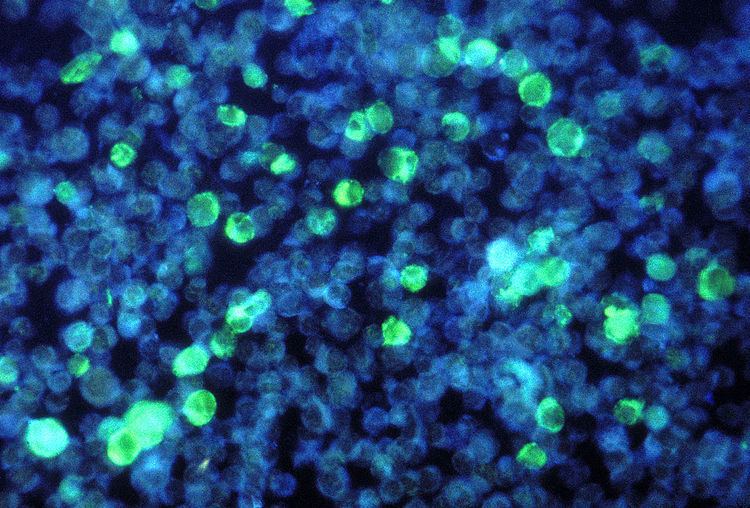ICD-9-CM 075 MeSH D020031 | OMIM 226990 | |
 | ||
There are several forms of Epstein–Barr virus infection. Infectious mononucleosis, nasopharyngeal carcinoma, and Burkitt's lymphoma can all be caused by the Epstein–Barr virus.
Contents
Infectious mononucleosis
Epstein–Barr can cause infectious mononucleosis, also known as 'glandular fever', 'mono' and 'Pfeiffer's disease'. Infectious mononucleosis is caused when a person is first exposed to the virus during or after adolescence. It is predominantly found in the developing world, and most children in the developing world are found to have already been infected by around 18 months of age. Infection of children can occur when adults mouth feed or pre-chew food before giving it to the child. EBV antibody tests turn up almost universally positive. In the United States roughly half of five-year-olds have been infected.
EBV-associated malignancies
The strongest evidence linking EBV and cancer formation is found in Burkitt's lymphoma and nasopharyngeal carcinoma. Additionally, it has been postulated to be a trigger for a subset of chronic fatigue syndrome patients as well as multiple sclerosis and other autoimmune diseases.
Burkitt's lymphoma is a type of Non-Hodgkin's lymphoma and is most common in equatorial Africa and is co-existent with the presence of malaria. Malaria infection causes reduced immune surveillance of B cells immortalized by EBV, resulting in an excessive number of B cells and an increased likelihood of an unchecked mutation. Repeated mutations can lead to loss of cell-cycle control, causing excessive proliferation observed as Burkitt's lymphoma. Burkitt's lymphoma commonly affects the jaw bone, forming a huge tumor mass. It responds quickly to chemotherapy treatment, namely cyclophosphamide, but recurrence is common.
Other B cell lymphomas arise in immunocompromised patients such as those with AIDS or who have undergone organ transplantation with associated immunosuppression (Post-Transplant Lymphoproliferative Disorder (PTLPD)). Smooth muscle tumors are also associated with the virus in malignant patients.
Nasopharyngeal carcinoma is a cancer found in the upper respiratory tract, most commonly in the nasopharynx, and is linked to the EBV virus. It is found predominantly in Southern China and Africa, due to both genetic and environmental factors. It is much more common in people of Chinese ancestry (genetic), but is also linked to the Chinese diet of a high amount of smoked fish, which contain nitrosamines, well known carcinogens (environmental).
Clinical symptoms
Symptoms of infectious mononucleosis are fever, sore throat, and swollen lymph glands. Sometimes, a swollen spleen or liver involvement may develop. Heart problems or involvement of the central nervous system occurs only rarely, and infectious mononucleosis is almost never fatal. There are no known associations between active EBV infection and problems during pregnancy, such as miscarriages or birth defects. Although the symptoms of infectious mononucleosis usually resolve in 1 or 2 months, EBV remains dormant or latent in a few cells in the throat and blood for the rest of the person's life. Periodically, the virus can reactivate and is commonly found in the saliva of infected persons. Reactivated and post-latent virus may pass the placental barrier in (also seropositive) pregnant women via macrophages and therefore can infect the fetus. Also re-infection of prior seropositive individuals may occur. In contrast, reactivation in adults usually occurs without symptoms of illness.
EBV also establishes a lifelong dormant infection in some cells of the body's immune system. A late event in a very few carriers of this virus is the emergence of Burkitt's lymphoma and nasopharyngeal carcinoma, two rare cancers. EBV appears to play an important role in these malignancies, but is probably not the sole cause of disease.
Most individuals exposed to people with infectious mononucleosis have previously been infected with EBV and are not at risk for infectious mononucleosis. In addition, transmission of EBV requires intimate contact with the saliva (found in the mouth) of an infected person. Transmission of this virus through the air or blood does not normally occur. The incubation period, or the time from infection to appearance of symptoms, ranges from 4 to 6 weeks. Persons with infectious mononucleosis may be able to spread the infection to others for a period of weeks. However, no special precautions or isolation procedures are recommended, since the virus is also found frequently in the saliva of healthy people. In fact, many healthy people can carry and spread the virus intermittently for life. These people are usually the primary reservoir for person-to-person transmission. For this reason, transmission of the virus is almost impossible to prevent.
The clinical diagnosis of infectious mononucleosis is suggested on the basis of the symptoms of fever, sore throat, swollen lymph glands, and the age of the patient. Usually, laboratory tests are needed for confirmation. Serologic results for persons with infectious mononucleosis include an elevated white blood cell count, an increased percentage of certain atypical white blood cells, and a positive reaction to a "mono spot" test.
Treatment
There is no specific treatment for infectious mononucleosis, other than treating the symptoms. In severe cases, steroids such as corticosteroids may be used to control the swelling of the throat and tonsils. Currently, there are no antiviral drugs or vaccines available.
It is important to note that symptoms related to infectious mononucleosis caused by EBV infection seldom last for more than 4 months. When such an illness lasts more than 6 months, it is frequently called chronic EBV infection. However, valid laboratory evidence for continued active EBV infection is seldom found in these patients. The illness should be investigated further to determine if it meets the criteria for chronic fatigue syndrome, or CFS. This process includes ruling out other causes of chronic illness or fatigue.
